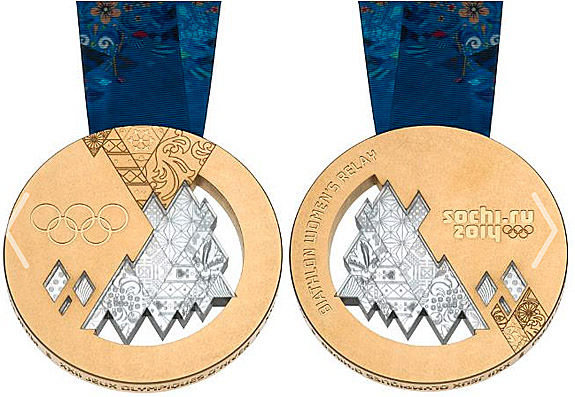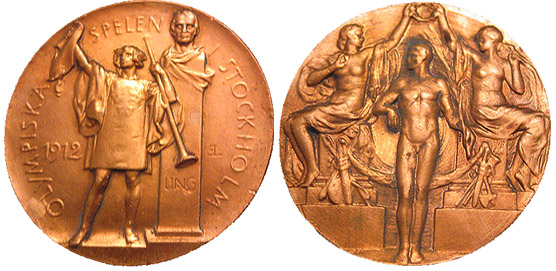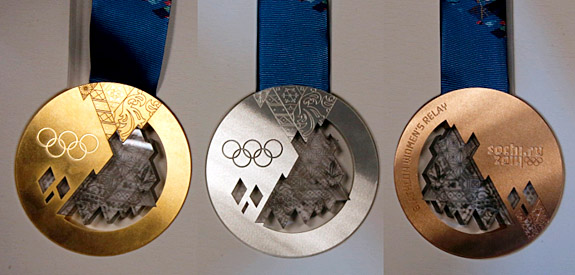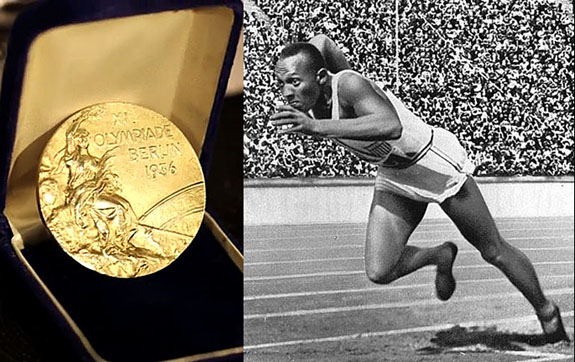February 18th, 2014
The 2014 Sochi Olympic gold medals are 10mm thick, 100mm wide and weigh in at a hefty 531 grams, or 1.17 pounds apiece. If the medals were made of pure gold — the way they were back in 1912 — each one would be worth a not-too-shabby $24,704.

But, alas, starting in 1916, the International Olympic Committee mandated that gold medals be made mostly of silver, with a gilding of exactly 6 grams (.211 ounces) of 24-karat gold. Since the Sochi medals are composed of 525 grams of 96% pure silver and 6 grams of 99.9% pure gold, the total precious metal value is about $610. That’s only 2.4% of the value of a pure-gold version.

The Sochi silver medals are even more disappointing value-wise. As with the gold medal, they are made of 525 grams of 96% pure silver, but they have no gilding. The precious metal value is only $332.

Bronze medals at Sochi weigh in at 460 grams and contain mostly copper with a bit of zinc and tin. The composition is similar to that of a penny. There is no precious metal in the medal and the value is less than $5.

Of course, the real value of an Olympic gold medal extends far beyond that of the precious metal. For example, a 1936 gold medal earned by Jesse Owens at the Games in Berlin, Germany, recently fetched $1.47 million at auction.
The Sochi Olympic medals are unique in that they seem to be missing a few puzzle-like pieces. The largest missing shape is actually filled in partly with a transparent polycarbonate material, making this is the first medal to ever to feature this element.
The medal's design represents the landscape of Sochi, with its snowy peaks and sandy beaches. The “patchwork quilt” elements are a tribute to the various cultures and ethnicities of the Russian Federation.
The front of the medals feature the Olympic rings, while the reverse side contains the name of the competition in English and the logo of the Sochi Games. The official name of the Games is engraved on the rim in Russian, English and French.
The Olympic organizing committee reported that the production of a single medal takes an average of 18 hours. The complex process includes casting, cutting, turning, electromachining, precision cutting and metal etching.
U.S. Olympic medal winners are automatically insured against the loss, theft or damage of their hard-earned treasures. Each medal is covered up to $5,000 through Liberty Mutual in partnership with the U.S. Olympic Committee. This service is being provided at no cost to U.S. athletes participating in the 2014 and 2016 Games.

But, alas, starting in 1916, the International Olympic Committee mandated that gold medals be made mostly of silver, with a gilding of exactly 6 grams (.211 ounces) of 24-karat gold. Since the Sochi medals are composed of 525 grams of 96% pure silver and 6 grams of 99.9% pure gold, the total precious metal value is about $610. That’s only 2.4% of the value of a pure-gold version.

The Sochi silver medals are even more disappointing value-wise. As with the gold medal, they are made of 525 grams of 96% pure silver, but they have no gilding. The precious metal value is only $332.

Bronze medals at Sochi weigh in at 460 grams and contain mostly copper with a bit of zinc and tin. The composition is similar to that of a penny. There is no precious metal in the medal and the value is less than $5.

Of course, the real value of an Olympic gold medal extends far beyond that of the precious metal. For example, a 1936 gold medal earned by Jesse Owens at the Games in Berlin, Germany, recently fetched $1.47 million at auction.
The Sochi Olympic medals are unique in that they seem to be missing a few puzzle-like pieces. The largest missing shape is actually filled in partly with a transparent polycarbonate material, making this is the first medal to ever to feature this element.
The medal's design represents the landscape of Sochi, with its snowy peaks and sandy beaches. The “patchwork quilt” elements are a tribute to the various cultures and ethnicities of the Russian Federation.
The front of the medals feature the Olympic rings, while the reverse side contains the name of the competition in English and the logo of the Sochi Games. The official name of the Games is engraved on the rim in Russian, English and French.
The Olympic organizing committee reported that the production of a single medal takes an average of 18 hours. The complex process includes casting, cutting, turning, electromachining, precision cutting and metal etching.
U.S. Olympic medal winners are automatically insured against the loss, theft or damage of their hard-earned treasures. Each medal is covered up to $5,000 through Liberty Mutual in partnership with the U.S. Olympic Committee. This service is being provided at no cost to U.S. athletes participating in the 2014 and 2016 Games.



